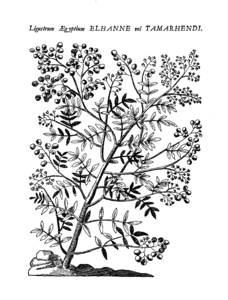Lawsonia inermis
Lawsonia inermis L.
| Ordre | Myrtales |
|---|---|
| Famille | Lythraceae |
| Genre | Lawsonia |
2n =
Origine : Iran, Inde
sauvage ou cultivé
| Français | henné |
|---|---|
| Anglais | henna |
- teinture corporelle
- plante tannante
- médicinal
- fleurs ornementales
- huile essentielle des fleurs
- plante magique
Sommaire
Description
Noms populaires
| français | henné ; réséda France, réséda-pays (Rollet) |
| anglais | henna, Egyptian privet ; reseda, mignonette-tree (Rollet) |
| portugais | hena, hésia |
| swahili | mhina, muhina |
Classification
Lawsonia inermis L. (1753)
Cultivars
Histoire
Elhanne Alpin 1735, De Plantis Aegypti, 19v ; 23
Usages
Widely cultivated in Near East, Middle Asia, SE Asia, S China, Japan, Philippines, N and SE Africa, tropical America. In these regions also often escaped from cultivation and naturalized. Today, the main areas of cultivation are India, Egypt and Sudan. Important crop also in N Australia, Pakistan, Madagaskar and Iran. Already cultivated in old Egypt. From the leaves a powder is produced, which is used for staining hands, finger-nails and feet red. Also hairs, beard and eye brows are stained. Formerly important for dyeing wool, silk and clothes, in mixture with other dyestuff different colours were obtained. After introduction of synthetic dyes henna lost its importance. Henna is also antiseptic and used prophylactically against skin diseases, e.g. in Afghanistan for this purpose the eye-lids are stained. The leaves are antiinflammatory. From the flowers an essential oil is obtained (henna or mehndi oil) for cosmetical use. The root is used in folk medicine. Also ornamental plant.
Références
- Aubaile-Sallenave, Françoise, 1982. Les voyages du Henné. Journal d'agriculture traditionnelle et de botanique appliquée, 29(2) : 123-178. doi : 10.3406/jatba.1982.3866, Persée.
- Bekele-Tesemma, Azene, 2007. Useful trees and shrubs for Ethiopia. Identification, propagation and management for 17 agroclimatic zones. Nairobi, ICRAF - RELMA. 550 p. (Technical Manual 6). Voir l'article
- Dodinet, Elisabeth, 2001. Histoire des aromates à usage thérapeutique et cosmétologique dans l'Ancien Testament. Mémoire Ecole des Plantes. 432 p.
- Gast, Marceau, 2000. « Henné », Encyclopédie berbère, 22. Openedition
- Rollet, Bernard et coll., 2010. Arbres des Petites Antilles. Tome 1 : Introduction à la dendrologie. 276 p. Tome 2 : Description des espèces. 866 p. + 46 pl. coul. + CD de photos sur l'anatomie du bois. Basse-Terre, ONF. Voir sur Pl@ntUse.







